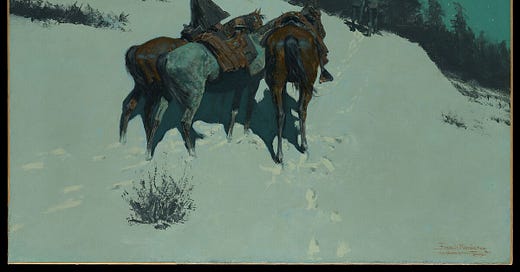Frederick Remington A Reconnaissance. 1902. Collection Metropolitan Museum of Art
“Darkness had settled slowly. . .toward the west and south was a monstrous shadow of the night, formless, imponderable. . .Soon all again was silence. The mountains across the mesa frowned with black shaggy brows and relapsed once more into slumber”
—Frank Waters (1902-1995) The Lizard Woman. 1930
The night belongs to no one, and to everyone. Places familiar in daylight no longer resemble themselves at night. While danger may lurk in the umbrage, starry skies have guided far-faring mariners and overland trekkers to safety; and the unlucky amongst them to Hamlet’s “undiscovered country.” Limited vision requires us to call upon other senses, memory, and the imagination. Fact melts into fiction, until the hard light of day breaks night’s spell.
On June 30, 2015, painted through the night at the summit of Kilauea, only to discover that despite an adequate headlamp, and with a geodesic survey marker for my easel, what began as an exercise in observation quickly became an exertion of memory. American painters, from Alfred Pinkham Ryder, Ralph Blakelock, Frederick Remington, to Georgia O’Keeffe, Edward Hopper, and Yvonne Jacquette, celebrated the night in their works. These artists resisted optical verisimilitude, despite the fact that both O’Keeffe and Jacquette were married to photographers, and the others would have had access to the medium.
Keep reading with a 7-day free trial
Subscribe to TRUE PLACES to keep reading this post and get 7 days of free access to the full post archives.




